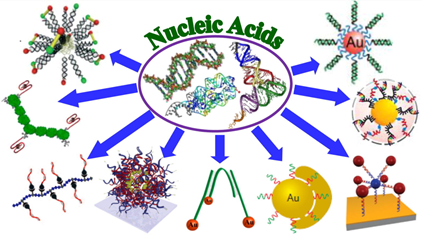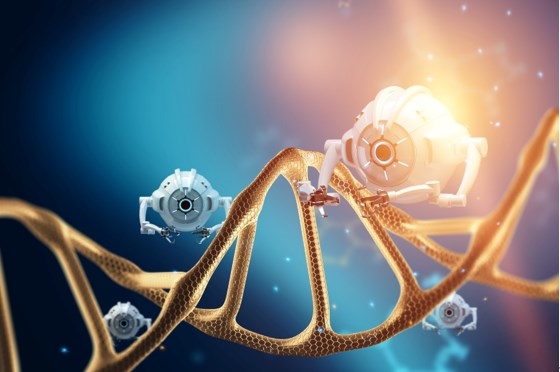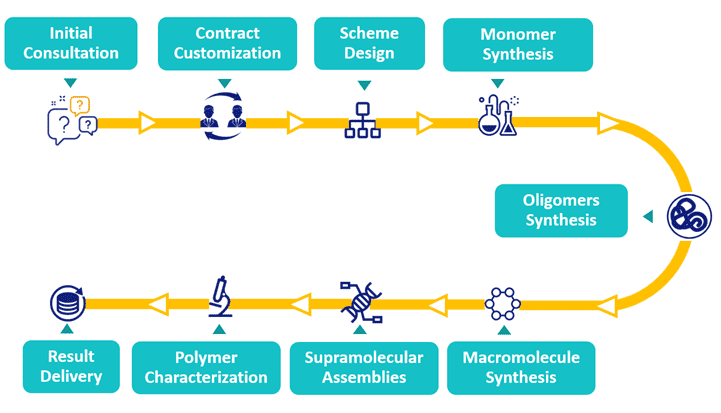Nucleic Acid-polymer Conjugates
Nucleic acid-polymer conjugates are afforded by click reactions of appropriately functionalized oligonucleotides with synthetic polymer chains of different chemical nature, composition, and properties. With expertise in bioconjugation, BOC Sciences has developed various strategies to offer tailor-made nucleic acid-polymer conjugation, protein-polymer conjugation, peptide-polymer conjugation, viruses-polymer conjugation, enzymes-polymer conjugation, liposome-polymer conjugation and carbohydrate-polymer conjugation services to our institutional and industrial customers.
Introduction of Nucleic Acid-polymer Conjugates
Nucleic acids can be bioactive in different forms (i.e., DNAzymes, aptamers, siRNA, etc.), thus imparting both structural and functional features for designing sophisticated biohybrid materials. The self-assembly of DNA strands is partly due to the intermolecular formation of H-bonds between the complementary purine (adenine and guanine) and pyrimidine (thymine and cytosine) bases of nucleic acids, which are attached to the phosphate sugar backbones. Mechanistically, adenine (A) selectively binds to thymine (T), whereas guanine (G) selectively binds to cytosine (C); thus, synthetic polymers bearing nucleobases (A, T, G, or C) should also exhibit interesting supramolecular self-assembly or self-sorting properties. Although many chemical and bioengineering techniques have been established for the site-specific labeling of DNA and RNA with functional small molecules, current approaches for polymer conjugating to nucleic acids mainly proceed at the terminus of oligonucleotide sequences, resulting in nucleic acid-containing block copolymers.
 Progress in Materials Science. 2017, 88: 136-185.
Progress in Materials Science. 2017, 88: 136-185.
Superior organization properties can be obtained when conjugating synthetic polymers with oligonucleotides. In comparison to the previous approaches, the supramolecular organization is not due to a random nucleobase recognition but instead to the cooperative association of sequence-defined oligomers. Moreover, the complementary self-assembly of oligonucleotides can be achieved in water because oligonucleotides possess the optimized backbone structure of natural nucleic acids. For example, the hydrophobic synthetic polymers and hydrophilic oligonucleotide fragments can constitute block copolymer amphiphiles, and such amphiphilic bioconjugates can prepare aqueous micelles capable of forming superstructures via co-assembly with materials (e.g., inorganic nanoparticles) exhibiting complementary oligonucleotides. Furthermore, bioconjugates of polymers and oligonucleotides can also be exploited for constructing microbiology or biotechnology materials such as DNA micro-arrays that are useful for diagnostic assays. Currently, oligonucleotides have already been conjugated to a wide variety of synthetic polymers, including polypyrrole, polynorbornene, poly(maleic anhydride-alt-vinyl ether), poly(N-vinyl pyrrolidone-co-N-acryloxysuccinimide), poly(N-(2,2-dimethox-yethyl)-N-methacrylamide), and poly(N-acryloylmorpholine-co-N-acryloxysuccinimide).
Applications of Nucleic Acid-polymer Conjugates
- Nanomaterials. The attachment of polymers to DNA sequences typically enhances the stability of DNA within the biological system, acting as a vehicle to cross cellular membranes and/or as a combinatorial platform for multimodal medical applications. They are widely applied in therapeutics, precision materials, nanorobots, ultrasensitive sensors, and molecular computers.

- Biomedical Science. Recent advances in the nucleic acid-polymer area attempt to integrate multiple functions (i.e., stimulus and temporal control, targeting, etc.) onto the polymeric scaffold and enhance nucleic acid molecules' bioactivity and pharmacological properties, especially for drug delivery and cellular imaging.
- Optoelectronic Devices. Nucleic acid-polymers can use DNA interactions to enhance polymer-derived functions. DNA-templated optoelectronic nanodevices fabrication has become a promising research area for many potential applications, such as fluorescence and optoelectronics.
Our Services for Nucleic Acid-polymer Conjugates
Nucleic Acid-templated Synthesis of Polymers
The fabrication of multifunctional nucleic acid-conducting polymer nanocomposites using DNA as a template can improve the properties of conducting polymers and has become an attractive application in nanotechnology. As an authoritative expert in polymer bioconjugation, BOC Sciences leads into a synthetic strategy for conducting polymer nanocomposites using mainly nucleic acids as soft templates. Our conductive polymers for nucleic acid bioconjugations include but are not limited to polyacetylene (PA), polyaniline (PANI), polypyrrole (PPy), polythiophene (PTh), poly(para-phenylene) (PPP), poly(phenylene vinylene) (PPV), and polyfuran (PF).
Nucleic Acid-templated Nanomaterial Synthesis
Nucleic acids are significantly used as bio-templates to control the growth of versatile nanomaterials because their carbonyl and amine moieties on the nucleobases can coordinate with metal ions, while the overhanging phosphate backbones can prevent irreversible aggregation of nanoparticles. Additionally, DNA/RNA nanotechnology can provide specific alignment of surface-modified nanoparticles to produce well-defined 1D, 2D, or 3D nano architectures, utilizing the molecular recognition property of nucleic acid. BOC Sciences is committed to developing precision polymer nanostructures for nucleic acids, nucleotides, and nucleobases. Our one-stop synthesis technology includes RNA-templated synthesis of nanoparticles and DNA-templated synthesis of nanoparticles.
Nucleic Acid-Polymer Hybrid
Nucleic acid-polymer hybrids have captured a stunning position and attracted incredible scientific and technological interest due to the facile procedure involving physical mixing guided by non-covalent interaction. Conducting polymer-DNA hybrids has versatile applications, including sensing of DNA hybridization, low potential flow detection of nucleic acid, etc. In addition to providing customized services for conductive polymer-DNA conjugation, BOC Sciences also offers dendronized polymer-DNA conjugation services, which may find utility in nonviral gene delivery.
Our Polymer Bioconjugation Workflow

References
- Nandi, A.K. et al. Nucleic acid based polymer and nanoparticle conjugates: synthesis, properties and application. Progress in Materials Science. 2017, 88: 136-185.
- Weil, T. et al. Polymer bioconjugates: Modern design concepts toward precision hybrid materials. Progress in Polymer Science. 2020, 105: 101241.
- Lutz, J.F. et al. Modern trends in polymer bioconjugates design. Prog. Polym. Sci. 2008, 33: 1-39.

 Progress in Materials Science. 2017, 88: 136-185.
Progress in Materials Science. 2017, 88: 136-185.













